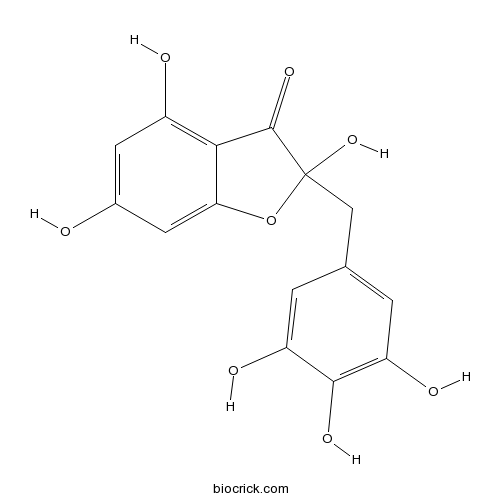Amaronol ACAS# 226560-96-9 |

Quality Control & MSDS
3D structure
Package In Stock
Number of papers citing our products

| Cas No. | 226560-96-9 | SDF | Download SDF |
| PubChem ID | 485521 | Appearance | Powder |
| Formula | C15H12O8 | M.Wt | 320.3 |
| Type of Compound | Flavonoids | Storage | Desiccate at -20°C |
| Solubility | Soluble in Chloroform,Dichloromethane,Ethyl Acetate,DMSO,Acetone,etc. | ||
| Chemical Name | 2,4,6-trihydroxy-2-[(3,4,5-trihydroxyphenyl)methyl]-1-benzofuran-3-one | ||
| SMILES | C1=C(C=C(C(=C1O)O)O)CC2(C(=O)C3=C(C=C(C=C3O2)O)O)O | ||
| Standard InChIKey | KZFYMOSMINTUQG-UHFFFAOYSA-N | ||
| General tips | For obtaining a higher solubility , please warm the tube at 37 ℃ and shake it in the ultrasonic bath for a while.Stock solution can be stored below -20℃ for several months. We recommend that you prepare and use the solution on the same day. However, if the test schedule requires, the stock solutions can be prepared in advance, and the stock solution must be sealed and stored below -20℃. In general, the stock solution can be kept for several months. Before use, we recommend that you leave the vial at room temperature for at least an hour before opening it. |
||
| About Packaging | 1. The packaging of the product may be reversed during transportation, cause the high purity compounds to adhere to the neck or cap of the vial.Take the vail out of its packaging and shake gently until the compounds fall to the bottom of the vial. 2. For liquid products, please centrifuge at 500xg to gather the liquid to the bottom of the vial. 3. Try to avoid loss or contamination during the experiment. |
||
| Shipping Condition | Packaging according to customer requirements(5mg, 10mg, 20mg and more). Ship via FedEx, DHL, UPS, EMS or other couriers with RT, or blue ice upon request. | ||
| Description | Standard reference |
| In vitro | Two auronols from Pseudolarix amabilis.[Pubmed: 10346966]J Nat Prod. 1999 May;62(5):767-9.
|

Amaronol A Dilution Calculator

Amaronol A Molarity Calculator
| 1 mg | 5 mg | 10 mg | 20 mg | 25 mg | |
| 1 mM | 3.1221 mL | 15.6104 mL | 31.2207 mL | 62.4415 mL | 78.0518 mL |
| 5 mM | 0.6244 mL | 3.1221 mL | 6.2441 mL | 12.4883 mL | 15.6104 mL |
| 10 mM | 0.3122 mL | 1.561 mL | 3.1221 mL | 6.2441 mL | 7.8052 mL |
| 50 mM | 0.0624 mL | 0.3122 mL | 0.6244 mL | 1.2488 mL | 1.561 mL |
| 100 mM | 0.0312 mL | 0.1561 mL | 0.3122 mL | 0.6244 mL | 0.7805 mL |
| * Note: If you are in the process of experiment, it's necessary to make the dilution ratios of the samples. The dilution data above is only for reference. Normally, it's can get a better solubility within lower of Concentrations. | |||||

Calcutta University

University of Minnesota

University of Maryland School of Medicine

University of Illinois at Chicago

The Ohio State University

University of Zurich

Harvard University

Colorado State University

Auburn University

Yale University

Worcester Polytechnic Institute

Washington State University

Stanford University

University of Leipzig

Universidade da Beira Interior

The Institute of Cancer Research

Heidelberg University

University of Amsterdam

University of Auckland

TsingHua University

The University of Michigan

Miami University

DRURY University

Jilin University

Fudan University

Wuhan University

Sun Yat-sen University

Universite de Paris

Deemed University

Auckland University

The University of Tokyo

Korea University
- 4,6,7-Trihydroxycoumarin
Catalog No.:BCC9203
CAS No.:22649-24-7
- Torachrysone
Catalog No.:BCN5069
CAS No.:22649-04-3
- Cinacalcet
Catalog No.:BCC1483
CAS No.:226256-56-0
- Methyl kulonate
Catalog No.:BCN7952
CAS No.:22611-37-6
- Kulactone
Catalog No.:BCN7953
CAS No.:22611-36-5
- Demethoxycurcumin
Catalog No.:BCN5974
CAS No.:22608-11-3
- Auriculine
Catalog No.:BCN2013
CAS No.:22595-00-2
- Lucidioline
Catalog No.:BCN7413
CAS No.:22594-91-8
- (+)-Catechin hydrate
Catalog No.:BCN2309
CAS No.:225937-10-0
- Cyclothiazide
Catalog No.:BCC6759
CAS No.:2259-96-3
- Epifriedelanol acetate
Catalog No.:BCN5068
CAS No.:2259-07-6
- PAR 4 (1-6)
Catalog No.:BCC3956
CAS No.:225779-44-2
- Amaronol B
Catalog No.:BCN5071
CAS No.:226561-02-0
- 3-Hydroxy-12-oleanene-23,28-dioic acid
Catalog No.:BCN1482
CAS No.:226562-47-6
- Fosamprenavir Calcium Salt
Catalog No.:BCC1581
CAS No.:226700-81-8
- Bakkenolide Db
Catalog No.:BCN7117
CAS No.:226711-23-5
- 2-(3,4-dihydroxyphenyl)-2-hydroxypropanoic acid
Catalog No.:BCN6296
CAS No.:22681-72-7
- NPS 2390
Catalog No.:BCC6119
CAS No.:226878-01-9
- Kaempferol-3-beta-O-glucuronide
Catalog No.:BCN2503
CAS No.:22688-78-4
- Quercetin-3-O-glucuronide
Catalog No.:BCN3149
CAS No.:22688-79-5
- Lansoprazole sodium
Catalog No.:BCC4298
CAS No.:226904-00-3
- 4-Hydroxy-1,10-secocadin-5-ene-1,10-dione
Catalog No.:BCN6661
CAS No.:226904-40-1
- LB42708
Catalog No.:BCC5344
CAS No.:226929-39-1
- Emapunil
Catalog No.:BCC5521
CAS No.:226954-04-7
Two auronols from Pseudolarix amabilis.[Pubmed:10346966]
J Nat Prod. 1999 May;62(5):767-9.
Two new auronols, amaronols A (1) and B (2), were isolated from the bark of Pseudolarix amabilis, along with pseudolaric acid B (3), pseudolaric acid C (4), demethoxydeacetoxy-pseudolaric acid B (5), pseudolaric acid B-beta-D-glucoside (6), pseudolaric acid A-beta-D-glucoside (7), and myricetin (8). The structures of amaronols A and B were established by spectral data interpretation as 2,4,6-trihydroxy-2-[(3',4',5'-trihydroxyphenyl) methyl]-3(2H)-benzofuranone and 2,4,6-trihydroxy-2-[(3', 5'-dihydroxy-4'-methoxyphenyl) methyl]-3(2H)-benzofuranone, respectively. Antimicrobial testing results of the eight compounds indicated that only pseudolaric acid B was active against Candida albicans (MIC, 3.125 microg/mL; MFC, 6.25 microg/mL), while myricetin was marginally active against Trichophyton mentagrophytes (MIC, 50 microg/mL).


